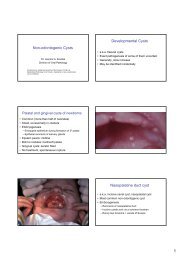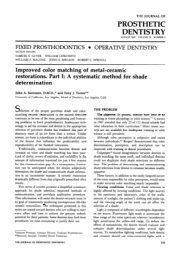Pulpal and Periapical Pathoses & Osteomyelitis
Pulpal and Periapical Pathoses & Osteomyelitis
Pulpal and Periapical Pathoses & Osteomyelitis
Create successful ePaper yourself
Turn your PDF publications into a flip-book with our unique Google optimized e-Paper software.
Irreversible Pulpitis<br />
•Early<br />
– Sharp, severe pain upon thermal stimulation<br />
– Pain continues after removal of stimulus<br />
– COLD uncomfortable (also warm <strong>and</strong> sweet)<br />
– Spontaneous or continuous<br />
– EPT: lower levels<br />
– Pain can be localized<br />
– Patient may be able to point to the offending tooth<br />
• With increasing discomfort, patient may be unable<br />
Irreversible Pulpitis<br />
• NO BLACK OR WHITE<br />
• Patients may have no symptoms<br />
• Severe pulpitis <strong>and</strong> abscess formation may be<br />
asymptomatic<br />
• Mild pulpitis may cause excruciating pain<br />
Irreversible Pulpitis<br />
•Late<br />
– Pain increases in intensity<br />
– Throbbing pressure (night owl)<br />
– Heat increases pain<br />
– Cold MAY PROVIDE RELIEF<br />
– EPT: HIGHER OR NO RESPONSE<br />
– Usually no mobility or sensitivity to percussion<br />
– If the inflammation spreads beyond the apical area you may<br />
get sensitivity to percussion<br />
Chronic hyperplastic pulpitis<br />
• Pulp polyp<br />
• Large exposure<br />
• Children or youth<br />
• Deciduous teeth<br />
• Hyperplastic granulation tissue that can become<br />
epithelialized from shedding epithelial cells<br />
• Open apex decreases the chances of pulpal necrosis<br />
2






